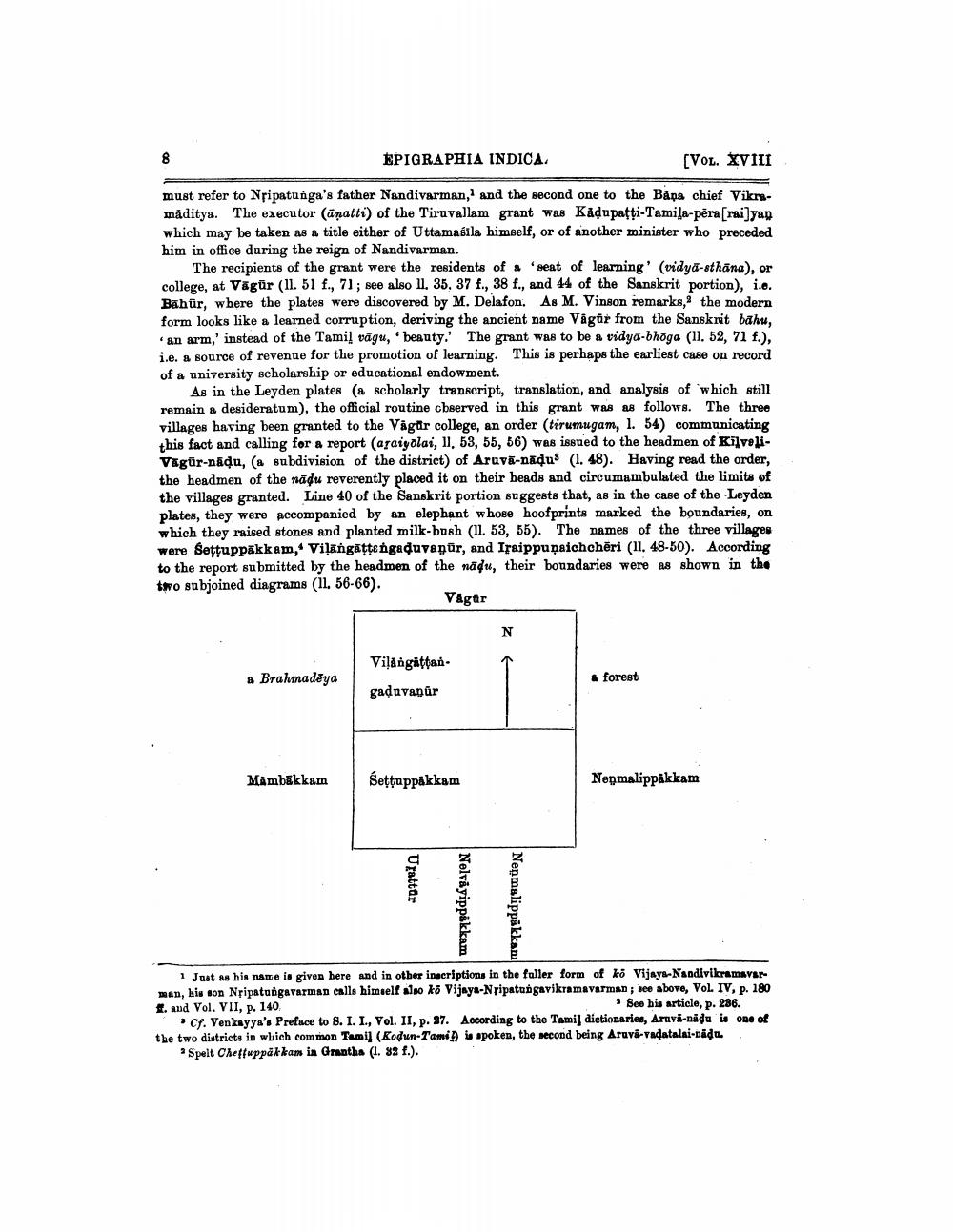________________
8
EPIGRAPHIA INDICA
[VOL. XVIII
must refer to Nripatunga's father Nandivarman,1 and the second one to the Bapa chief Vikramaditya. The executor (anatti) of the Tiruvallam grant was Kadupatti-Tamila-pera [rai]yan which may be taken as a title either of Uttamasila himself, or of another minister who preceded him in office during the reign of Nandivarman.
The recipients of the grant were the residents of a seat of learning' (vidya-sthāna), or college, at Vägür (11. 51 f., 71; see also 11. 35, 37 f., 38 f., and 44 of the Sanskrit portion), i.e. Bahur, where the plates were discovered by M. Delafon. As M. Vinson remarks, the modern form looks like a learned corruption, deriving the ancient name Vagür from the Sanskrit bahu, an arm,' instead of the Tamil vägu, 'beauty.' The grant was to be a vidya-bhoga (11. 52, 71 f.), i.e. a source of revenue for the promotion of learning. This is perhaps the earliest case on record of a university scholarship or educational endowment.
As in the Leyden plates (a scholarly transcript, translation, and analysis of which still remain a desideratum), the official routine cbserved in this grant was as follows. The three villages having been granted to the Vägar college, an order (tirumugam, 1. 54) communicating this fact and calling for a report (araiyolai, 11, 53, 55, 56) was issued to the headmen of KilveliVägür-nādu, (a subdivision of the district) of Aruva-nadus (1. 48). Having read the order, the headmen of the nadu reverently placed it on their heads and circumambulated the limits of the villages granted. Line 40 of the Sanskrit portion suggests that, as in the case of the Leyden plates, they were accompanied by an elephant whose hoofprints marked the boundaries, on which they raised stones and planted milk-bush (11. 53, 55). The names of the three villages were Seṭṭuppakkam, Vilangaṭṭengaduvanür, and Iraippuṇaichcheri (11. 48-50). According to the report submitted by the headmen of the nadu, their boundaries were as shown in the two subjoined diagrams (11. 56-66).
Vågür
a Brahmadeya
Mambakkam
Viļāngāṭṭan. gaḍuvapür
Settuppakkam
Urattür
Nelvayippakkam
N
Neņmalippakkam
& forest
Neņmalippakkam
1 Just as his name is given here and in other inscriptions in the fuller form of ko Vijaya-Nandivikramavarman, his son Nripatungavarman calls himself also ko Vijaya-Nripatungavikramavarman; see above, Vol. IV, p. 180 f. and Vol. VII, p. 140. See his article, p. 236.
Cf. Venkayya's Preface to 8. I. I., Vol. II, p. 27. According to the Tamil dictionaries, Arava-nadu is one of the two districts in which common Tamil (Kodun-Tamil) is spoken, the second being Aruva-vadatalai-nādu. Spelt Cheffuppakkam in Grantha (1. 32 f.).




